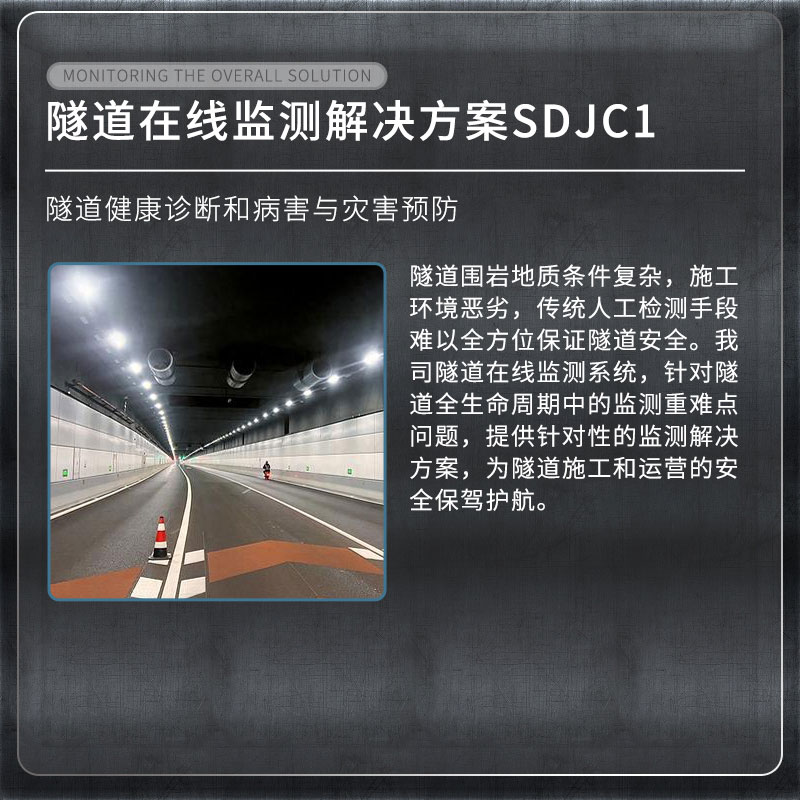Tianyi Sensor IOT Technology Co., Ltd
Sales Manager:Ms. Emily Wang
Cel,Whatsapp,Wechat:+86 15898932201
Email:info@fengtutec.com
Add:No. 155 Optoelectronic Industry Accelerator, Gaoxin District, Weifang, Shandong, China

Sales Manager:Ms. Emily Wang
Cel,Whatsapp,Wechat:+86 15898932201
Email:info@fengtutec.com
Add:No. 155 Optoelectronic Industry Accelerator, Gaoxin District, Weifang, Shandong, China

Model:FT-SDJC1
Brand:tianyi
1.Tunnel monitoring monitoring background
Tunnel monitoring can measure the condition of the tunnel, monitor ground and facility performance in real time, and monitor surrounding environmental conditions.In recent years, with the rapid development of my country's economic construction and cities, and the rapid development of infrastructure construction such as highways, high-speed rail, and subway, my country's tunnel construction work has entered a period of rapid development, and various tunnel accidents that have followed have also occurred frequently.The soil engineering geology and hydrogeological conditions that the tunnel passes through are complex and changeable.The existing tunnels are affected by deterioration of geological conditions, fires, structural damage, degradation and instability, natural disasters, etc., and often occur in tunnel arch cracks, side wall cracks, lining damage, tunnel water leakage, tunnel frost damage, and large deformation of surrounding rocks.It is extremely important to conduct health diagnosis and disease and disaster prevention and control of active operating tunnels or tunnels during construction.
2.Overview of Tunnel monitoring system
The geological conditions of the surrounding rock of the tunnel are complex and the construction environment is harsh.It is difficult for traditional manual inspection methods to ensure the safety of the tunnel in all aspects.Our online tunnel monitoring system provides targeted monitoring solutions to the key and difficult monitoring issues in the entire life cycle of the tunnel to protect the safety of tunnel construction and operation.
3.Main monitoring contents of Tunnel monitoring
1.Deformation monitoring: vault settlement and convergence monitoring, internal displacement of surrounding rock;
2.Force monitoring: anchor rod axial force, initial support stress, second lining stress, surrounding rock and primary contact pressure, primary support and secondary liner contact pressure, steel arch stress;
3.Groundwater monitoring: water pressure;
4.Environmental monitoring: temperature and humidity, smoke;
5.Monitoring of existing diseases: cracks;
6.Source of risk:
① Construction monitoring: uneven settlement, inclination, cracks;
② Surface monitoring: uneven settlement;
③ Monitoring of the cave entrance slope: surface displacement, internal displacement, rainfall, and soil moisture content.
4.List of Tunnel monitoring monitoring items
| Monitoring items | Device name | Monitoring items | Device name |
| Convergence of clear space | Laser rangefinder | Pressure between surrounding rock and primary branch | Soil pressure gauge |
| Sinking of the vault | Laser rangefinder | First branch two lining pressure | Soil pressure gauge |
| Uneven settlement of the surface | Static level | First support and second lining stress | Buried strain gauge |
| Uneven settlement of buildings | Static level | Internal displacement of surrounding rock | Multi-point displacement meter |
| Steel arch stress | Strain gauge | Surface buildings tilt | Box type fixed inclinometer |
| Anchor shaft force | Rebar meter | Cracks in surface buildings | Crack meter |
5.Tunnel monitoring basis
"Technical Specifications for Highway Tunnel Construction JTG/T 3660-2020"
"Technical Specifications for Highway Tunnel Construction Monitoring" (Draft for Soliciting Comments)
"Technical Specifications for Urban Tunnel Maintenance DB41∕T 1271-2016"
"Technical Regulations on Monitoring and Measurement of Railway Tunnels Q/CR9218-2015"
"Technical Specifications for Highway Tunnel Maintenance JTG H12-2015"
"Technical Specifications for Highway Tunnel Construction JTGF60-2009"
"Technical Regulations on Monitoring and Measurement of Railway Tunnels TB10121-2007"
6.Tunnel monitoring implementation function
1.Full life cycle monitoring: By laying corresponding sensor equipment in the tunnel or outside the second lining during the construction period, the tunnel deformation and stress are automatically monitored to realize the full life cycle monitoring of the tunnel.GIS+BIM is used for comprehensive display of visual models, master the entire life cycle state of the tunnel, and provide a decision-making basis for management;
2.Automatic report push: In addition to real-time display of monitoring results, the system will automatically generate corresponding daily reports, and one-click download is supported.Once the data exceeds the threshold, timely warnings and notify relevant units to take corresponding measures in a timely manner;
3.Leveled early warning: Set different early warning levels according to requirements.When the data is abnormal, the early warning information will be automatically triggered according to the settings, including platform push, text messages and email notification to the corresponding person;
4.Accumulate tunnel status data: provide necessary decision-making basis for long-term operation and maintenance, maintenance and reinforcement of tunnels, and provide basis for the assessment of the safety status of the tunnel after emergencies.At the same time, AI algorithm is used to predict the structural response and development of the bridge in the future time period;
5.Provide reference basis: verify the design and construction theory and construction technology of the tunnel, thereby improving relevant design and construction technical regulations and ensuring the safety of the tunnel's use.
How to solve the problems of water pollution and water quality deterioration? Traditional manual sampling is time-consuming and lagging, but now there is a more efficient solution - the Water Quality Monitoring Buoy!As a key piece of equipment for water environment monitoring, its development precis...
As the impacts of climate change continue to intensify, the frequency and destructive scale of flood disasters are on the rise, posing severe threats to public safety and socio-economic development. Summer is inherently a high-risk period for disasters such as floods and droughts. To further enhance...
3D Ultrasonic Anemometer can measure the horizontal and vertical wind speed and direction values in three-dimensional space at high frequency, providing accurate and real-time data support for various industries.The working principle of this sensor is based on the propagation characteristics of ultr...
Ports serve as critical hubs connecting the ocean and land, with numerous vessels entering/exiting and cargo being loaded/unloaded daily. However, due to their unique geographic locations, ports face complex and variable meteorological conditions. Among these, wind speed and direction significantly...